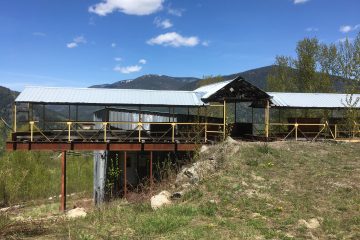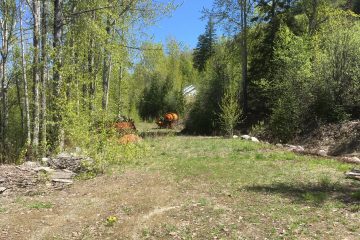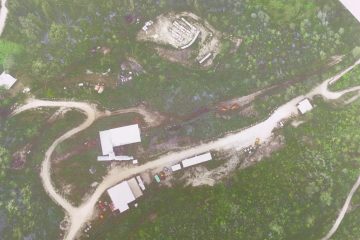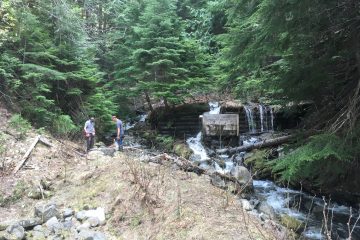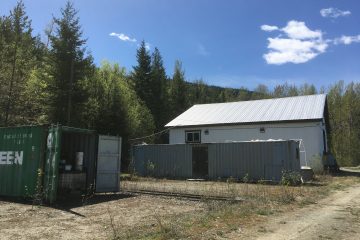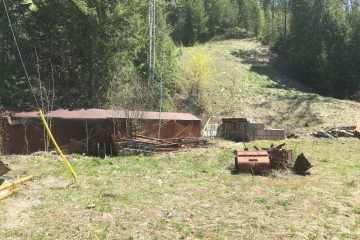Overview
In 2019, Ximen acquired 100% of the former producing Kenville Gold Mine crown granted mineral claims and the surface rights along with all existing permits, infrastructure and equipment.

Past drill programs give evidence of the extension of the high‐grade vein structures to substantially higher quantities of Gold on the adjacent claims. Ximen is confident that the current trend likely extends throughout the area, with over half the property unexplored. Ximen’s mission is to exploit the high-grade vein structures with current technology and become a high-grade producing gold mine while concurrently exploring the limits of the reserve. The estimated life expectancy of the mine is 20 + years.
The Company received Mines and Environment permits in 2023, giving it approval to construct the new Venango Portal, drive 1,200 m of underground mine decline, and conduct underground drilling (20,250 m). This work is aimed at outlining a 10,000 tonne bulk sample.
Before construction can be started there are a few permit conditions that must be met, which the Company is actively working on with its site Manager and external consultants.
One of the conditions is relocation of the terminus of the site drainage channel. An initial site investigation was conducted by representatives from local stakeholders, BC Ministry of Transportation and Infrastructure, civil engineering and environmental consultants for the Company, and the site manager. The initial assessment was positive; the limited scope of the project was defined, and plans were developed to advance the project. The Company anticipates the civil works will be permitted and completed in 2024.
The Company expects to complete all the engineering and environmental requirements and start construction of the underground mine in 2024.
To date, the 257 Level portal has been restored, surface buildings and roads have been rehabilitated, the portal site for the decline was stripped, a transformer for hydropower supply was installed, and all necessary underground mining equipment including a new mine compressor, a 3-yard scooptram, 13-tonne rock truck, long-tom drills and fans have been acquired. Water and waste rock quality surveys were completed, showing that the mine drainage water is high quality and the waste rock is non-acid generating. The Company intends to be extracting a bulk sample this year and then be in a position to move toward continuous production.F
Brief History
The Kenville Mine (formerly Granite-Poorman Mine) property is located 8 kilometres west of the town of Nelson in the West Kootenay region of British Columbia’s south-eastern interior. The mining property consists of 15 Crown‐granted mineral claims and 3 mineral claims, totalling 567 hectares. All of the Kenville Mine claims are wholly owned. The company also owns surface rights to four of the crown grants.

From “Technical (Geological) Report on the 257 Level of the Kenville Gold Mine, Nelson, British Columbia”, dated July 22, 2009, authored by Richard Munroe, FGAC, P.Geo., available on SEDAR under the Gungnir Resources issuer profile (filed October 7, 2009).
A qualified person has not done sufficient work to classify the historic estimate as current mineral resources or mineral reserves. As such the issuer, Ximen Mining Corp., is not treating this historical estimate as current mineral resources or mineral reserves.
Ximen considers this historic mineral resource estimate to be relevant and reliable in that it was based upon the results of underground sampling and diamond drill information available at the time. The historic mineral resource estimate uses the categories of Measured, Indicated and Inferred mineral resources as defined by the Canadian Institute of Mining, Metallurgy and Petroleum. Estimations were done using a polygonal method. Measured and Indicated Resources are based on projections of mineralized veins exposed on the 257 Level. Inferred Resources in the historical estimate are based on assumed continuity beyond measured and (or) indicated resources. The inferred mineral resources are based on historical drill and channel assay information verified by underground channel samples collected in 2007/8. The resource tonnages were estimated using an assumed specific gravity. A cut-off grade of 1.1 grams per tonne was used. No allowance for dilution was included based on an anticipated “resue” mining method, which would separate mineralized material from waste rock.
Subsequent to that report, Anglo Swiss drilled several additional diamond drill holes from surface and underground between 2009 and 2012 that intersected multiple gold-quartz veins west and south of the mine.
Since acquiring the project, Ximen has secured permits for the development of a new underground decline to access an area west and south of the historic mine where a series of gold-quartz vein intercepts were obtained. Ximen believes this area is a continuation of the gold deposit that was mined historically. Ximen rehabilitated the portal to the 257 Level of the Kenville Gold mine to provide access to the area of historic mineral resources that were reported in the 2009 technical report.

As part of its on-going technical studies on material from the Kenville Gold Mine, Ximen re-sampled and check assayed 13 samples of core from selected drill hole intercepts obtained in the years 2007 to 2011 inclusive. The verification assay results are reported in the Company’s press release dated February 19, 2020. In addition, assays were completed on two composite samples labelled as “High Grade” and “Low grade” that were used for metallurgical testing. Metallurgical test results on these samples were announced in a news release dated May 22, 2020.
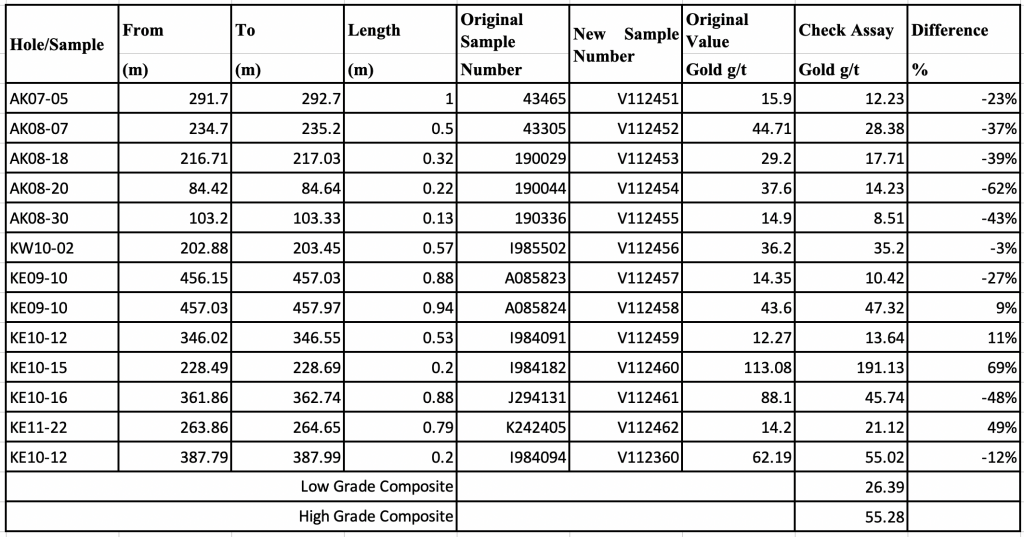
The average grade of the check assays is 38.51 whereas the average of the original values is 40.48 grams per tonne gold, a difference of only -5%. In addition, 11 of 13 (85%) of the check assays are within +/- 50 percent of the original values (see graph). The check assays compare reasonably for this type of coarse gold bearing mineralization and are therefore considered to verify the original drill core assays.
Check assays were performed by MSALABS at Langley, BC, an independent commercial laboratory, accredited with ISO/IEC Standard 17025. Samples were prepared pulverized a 250 gram split to 85% passing 75 microns. Gold analyses were performed on 30 gram subsamples. Sample # 112460 was subjected to a duplicate 30g high grade fire assay (with a detection range of 0.05 – 1000 g/t Au) with gravimetric finish while the remaining samples were each subjected to a single 30g ore grade fire assay (with a detection range of 0.01 to 100 g/t Au) with AA finish.
The Kenville material responded exceptionally well to both gravity and flotation. The combined gold recovery is 99%, with gravity gold recovery of 51%.
The test work started with a sample composited from the Kenville mineralization. Material was sorted on the basis of visible sulphide mineralization and separate lots were assayed. Portions of high-grade and low-grade material were then combined to give a weight average grade approaching the expected grade of material to be mined from Kenville 0.5 ounce per ton gold (17.1 grams per tonne) when the project proceeds to a Bulk Sample. The resultant composite assayed 16.27 grams per tonne gold and 35.60 grams per tonne silver (0.475 ounce per ton gold, 1.0 ounce per ton silver).
The material was then subjected to gravity gold recovery and flotation testing aimed at approximating the process at the target processing plant. The test process involved the following steps:
• Grind to P80 of 150 microns. Conduct PSA.
• Concentrate panned to extinction for Au. Pan tails returned to gravity tailings.
• Rougher-scavenger flotation test on gravity tailings to recover Au. Assay for Au, Ag, and multi-element ICP.
• 3 stages of cleaner flotation. Assay for Au, Ag, and multi-element ICP.
The following diagram depicts the test program executed:

A summary of the test results is given in the following table:

Nelson Area
Following acquisition of the Kenville mine, Ximen acquired additional mineral tenures surrounding the Kenville mine in the Nelson area, the most significant of which is the Star property. The total land package amassed to date is 21,560 hectares (including Kenville).
The acquired claims cover numerous historic mines and mineral occurrences and have had extensive historical exploration and small-scale mine production. Ximen is in the process of permitting drilling for the Star, Venus-Juno and California mine properties. Targets include large-tonnage, bulk-mineable gold-copper deposits and high-grade gold-silver deposits.
